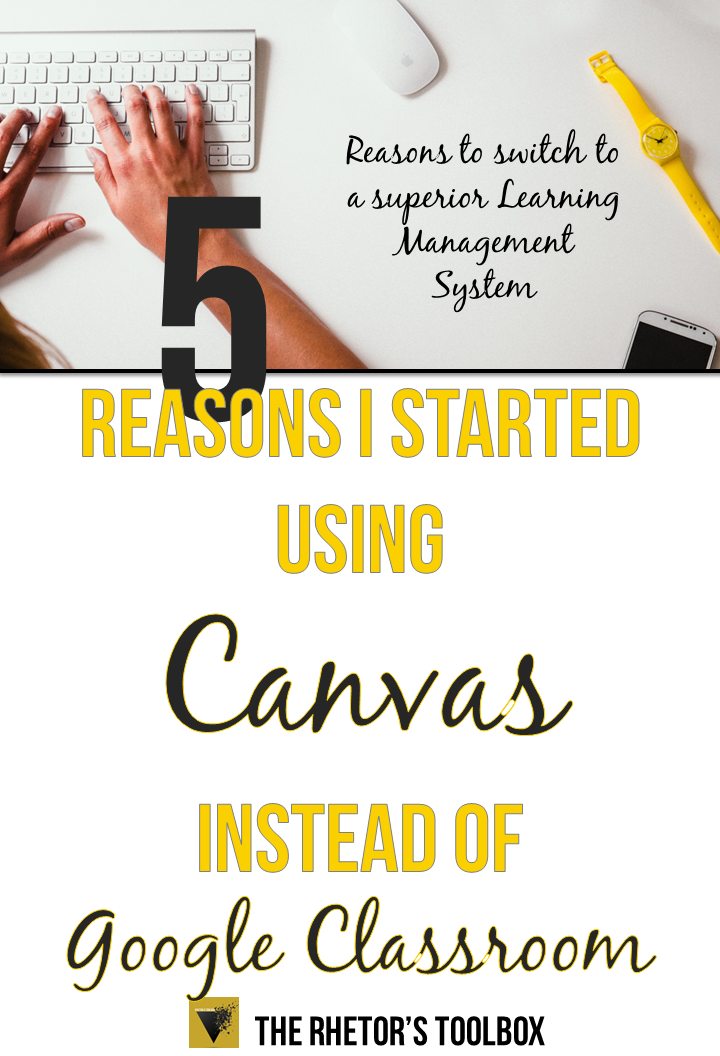It’s official: Classroom and I are no longer together. It was an amicable breakup. We just drifted apart. And I found a better LMS.
Enter Canvas. I used it in grad school, and I loved it. When I found out it was free, I was sold. When I mentioned the switch to my colleagues, I was met with disbelief. It took a bit of explaining, but my PLC is now on board with me–and we’re not looking back.
Perhaps you, too, have some lingering dissatisfaction with Classroom. I’d love to persuade you to join me on Canvas. It’s important for you to know up front that Canvas is free, and there’s nothing in this review for me. I’m just *this* excited to share it with you! Here are the most important reasons for my switch.
- Canvas is learning-centered. Here are several reasons:
- Outcomes and mastery grading. Canvas allows you to enter in standards/outcomes and map students’ performance to those standards. You can even link specific criteria from rubrics to standards.
- Modules can be set to allow self-pacing. If you want, you can set modules to stay closed until students have completed a prerequisite. This is fantastic for differentiating. Your advanced students can accelerate through content, while you can monitor students’ progress and catch struggling students before they’re overwhelmed.
- Using SpeedGrader, you can record audio/video, making feedback faster and more personal.
- Online discussions are easier to generate, follow, moderate, and grade. You can assign them to specific groups. You can require students to post original content before seeing other responses. Students can collaborate more effectively while being held accountable for what they bring to the conversation.
- The analytics are fantastic. Teachers and administrators love data! Canvas does all the number crunching automatically, and the results are easy to read and interpret.
2. Canvas is inclusive. I don’t have to research a plug-in for every blasted feature I want or need, then install it on 38 machines and make my students install it, too. I don’t need my students to create a bazillion accounts for different tech tools. It has everything I need and some things I haven’t even discovered! A few of my favorite features are the mastery grading and the conference function. Big Blue Button, the conference platform, is integrated, so I can just start an online conference with my students and record it for those who are unable to attend.
3. Canvas is organized. Let’s be honest: tagging posts that appear in a stream is an unrealistic way to organize online content for students and teachers to navigate. With Canvas, I can create discrete modules for units and resources. I can hide them when I want. I can automatically link materials, assignments, and feedback in the same place. When I’m creating course pages, all of my files and assignments are available to the side of the screen so I can cross link everything with virtually no effort.
4. Canvas is flexible. I can create groups and assign different tasks. I can move pages around and control what students see first (priorities!). I can still have students collaborate through Google Docs from within the Canvas system. If I do feel like adding in features, I can do so through a well-organized, searchable catalogue of add-ons. And one of my favorite features: I can create a master copy of a class and simply make a duplicate for my actual course. I’ll always have a clutter-free version to start with at the beginning of each year. The settings are easy to modify and offer ample ways to customize my class.
5. Canvas is sophisticated. I can create quizzes that can function as interactive notes. I have the option to edit using HTML, but the text tools are fully functional. When I upload documents–even PDFs–they open within Canvas, eliminating issues of file compatibility. I can monitor my students’ individual progress toward mastery of specific skills. Even cooler, I can assign peer to peer review, give draft/final grades, and give secondary grades. Then there’s an app–which functions for students and teachers–that is incredibly user-friendly.
If you’re interested in making the leap to Canvas, you can check out some fantastic video tutorials here. I also have tons of tech ideas, including Canvas, on my Classroom Technology Pinterest board.

